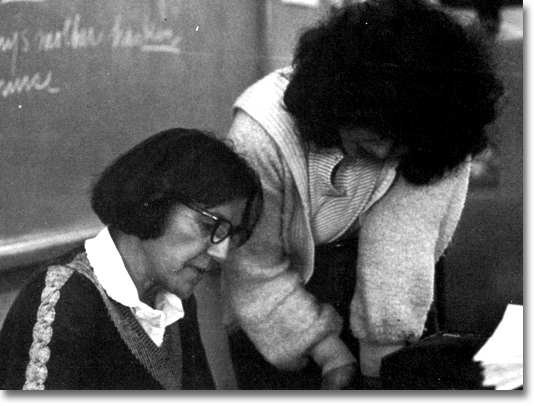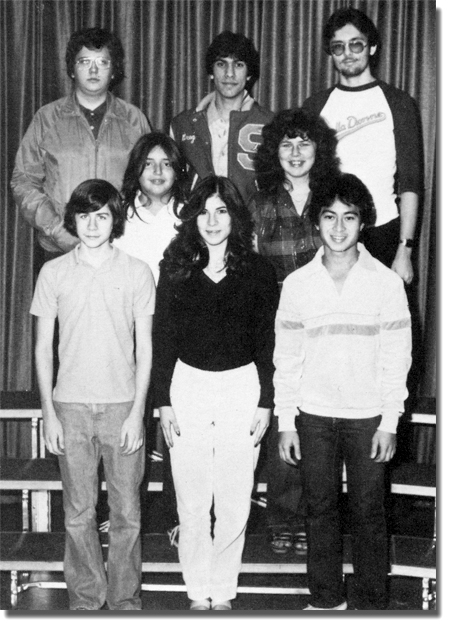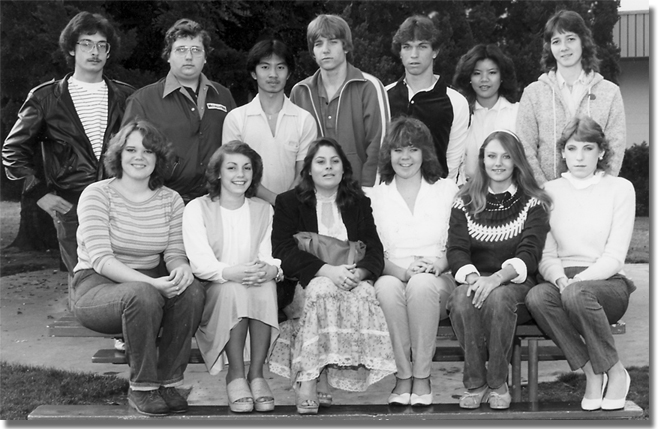I was on the staff of The Dispatch for my junior and senior years in high school. The first year I was the business manager, of which I can only say that we managed to pay our bills anyway; the second year, for my sins, I was the Editor-in-Chief. That's why I have still have these things; it's also why I hadn't thought to keep the issues from my sophomore year (I was a freshman at another school).
For some time in the 1960s, I believe there was an actual journalism class, so you took Journalism the first year and Newspaper the next. By the time I attended, Journalism was long-gone, so the newspaper staff was just another elective. More likely, though, the faculty advisor invited people to join. Mrs. Cecilia Tate taught Sophomore English and acted as the Katherine Graham of the paper almost from the beginning, so she got a close look at everyone's writing skills early on.
A few memories from my time:
The paper was printed by the district office and they charged us a fee to do it; it depended on the circulation and the number of issues. In previous years we had published six issues; but the year I joined the district offered to go up to eight—provided we paid the extra charges.
The bill was footed by the school, and even though it was already budgeted, we still had to go to the student council and ask for it. We asked for the base budget plus the extra to go for eight issues. It meant more work for us, but it also meant that the newspaper would be a little more timely. It seemed like eons between issues already, and the huge lag made covering events like sports and dances almost pointless, since the event was a dim memory by the time the paper actually came out.
The student council said no, six issues was enough. Being teenagers, we said screw that, we'd publish eight anyway so we joined the other clubs and organizations that had to sell candy to our unfortunate friends and families.
That done, we would go down to the district office to get our publication dates. The district would only do one or two papers each week, so every school with a newspaper would participate in a lottery of available dates, and then frantically consult a calendar and trade with other schools in order to spread the dates into something halfway evenly spaced; otherwise it was entirely possible to have six issues before Christmas and the final two in late May.
The only computers on campus were the Apple II+'s in the Chemistry room and they were constantly being used to play Castle Wolfenstein and Zork; we typed stories up on a couple old manual typewriters and marked them up. When it was our week to publish, we'd take the stories to the district office where a lady (I can picture her but can't remember anyone's name—sorry folks) would type them in the word processor and give us the type-set printout. Photos would be half-toned and printed out on the same type of paper.
We would take a piece of heavy paper that was the actual size of the page and tape it down onto a light table. We would cut up our printed stories and photos, run them though a machine that dribbled hot wax on the back, and stick them down where we wanted. That's where cut-and-paste comes from, literally. All of this was done by hand. Graphic elements like boxes around photos and black lines were done with graphic arts tape that was stretched down and pressed into place. It was extremely difficult to make things line up perfectly, and explains a lot of the wobbles and stray marks on the printed pages.
I don't remember the actual number but our circulation was something like 1,400 issues: 1,200 for our student body, around 80 or so to mail off to various another school newspapers who would send us theirs in return, and there rest for the faculty, staff, advertisers, and whomever else wanted an issue.
At the time, exchange copies—we got other school newspapers in exchange for ours—seemed like a waste of money but it was interesting to see how other people lived. I remember one paper (can't remember its name, though) from the midwest that didn't look like any other newspaper anywhere. Another had a weird column called "Uncle Earl from 'Nam" (another item that hasn't made it to Google searches). My favorite paper had a cartoon strip by Greg Evans called "Fogarty". A few years later he would start a new strip called Luann and Mr. Fogarty became a minor character in it.
A couple of papers, like the one from Beverly Hills High, came out daily and looked better than some "real" newspapers; I hated them. We also got at least one that looked as if it had been typed on an old Pica typewriter and directly printed using a library Xerox machine. So in terms of production quality we were around the middle of the pack.
Photography came from various sources. We got a lot of help from the yearbook staff, but photography was my hobby so some of the photos were mine. I also had a darkroom in my garage so we could get prints a lot faster than going through the yearbook, which contracted the darkroom work out with a local photo studio.
One of the interesting things about the photography was that I'd always been told to use B&W film because color didn't print out well in B&W. One day I took some photos and all I had was color film. We couldn't do the shots over so we just took a chance and they printed beautifully in the paper. If cost hadn't been a factor, we would have shot everything in color.
I was signing my name as "James A. Ollinger, Esq." at the time to everything for no good reason, just because I liked it. My first year, the Editor-in-Chief told me I couldn't have the esquire, so of course being a teenager that meant I damn well would have it. So for the first year I was there, the title appears or not depending on which one of us last touched the layout at the district office. The next year I was the Editor and I could have put it in 60 point Futura Extra Bold if I'd wanted, but there was no fun in it then.
Over the summer, Mrs. Tate had let me borrow the newspaper morgue that she had and I was able to see the evolution of the Dispatch from birth-to-date. So when I became Editor the next Fall, I had a bunch of things I wanted to do. In order not to be autocratic, I put various thing up to a vote. I had wanted to go back to a full-width banner masthead at the top of the paper, the kind most folio newspapers still have (picture the front page of the Orange County Register or the LA Times), instead of the small "floating" masthead we had been using the last couple years. That got voted down. But we did go back to the cartoon staff-box (the section that lists who's who on the paper). I did declare that we were going to put a black border around all the photos and that was not negotiable nor eligible for a vote and it didn't matter whether anyone liked it or not; but really I was the only one who cared.
Each page had its own editor: News, Opinion, Features and Sports. The page editors were responsible for assigning stories, copy-editing, photo-editing, layout and the final paste-up. Sports and Features were the popular ones; News as dull but showy. The Editor-in-Chief usually ended up with the Opinion page because nobody wanted it.
That's not to say that we weren't opinionated, we were. But there was no way in Hell we were going to be able to run unsigned editorials speculating on whether seagulls were being passed off as hamburger in the cafeteria; we mostly had to pick serious news stuff like politics which bored most of us silly. My immediate predecessor had a social conscience and enjoyed writing editorials; I was much more interested in writing angry movie reviews. Unfortunately, my senior year the Features Editor hated my movie reviews so that was the end of being young Roger Ebert.
 The faculty advisor, Mrs. Tate, had a deserved reputation for being stern, though I got to see her more relaxed a couple times. Considering how tightly-wound she often seemed, she gave us a lot of freedom to make the paper as we saw fit. I can only remember one big error on my part; a recent student had died and I had to put a short obituary on the front page (Volume XX, #6). I was the News Editor at the time, so when I laid out the page I put a heavy black box around it and put it on the bottom of the page. Being teenagers, final layout and paste-up was done at great speed, great energy and at the last minute. Mrs. Tate was furious at the placement of the obit, saying it looked like a headstone.
The faculty advisor, Mrs. Tate, had a deserved reputation for being stern, though I got to see her more relaxed a couple times. Considering how tightly-wound she often seemed, she gave us a lot of freedom to make the paper as we saw fit. I can only remember one big error on my part; a recent student had died and I had to put a short obituary on the front page (Volume XX, #6). I was the News Editor at the time, so when I laid out the page I put a heavy black box around it and put it on the bottom of the page. Being teenagers, final layout and paste-up was done at great speed, great energy and at the last minute. Mrs. Tate was furious at the placement of the obit, saying it looked like a headstone.
Looking back on these pages as I scanned and assembled them—I'm amazed at how much I've forgotten. I have no memory at all of the collage that makes up the cover of Vol 21, #7, except that I know it wasn't my idea and had nothing to do with it (that's not an insult; I like it, I just don't want to steal credit for it). A Dale & Donna cartoon made me laugh and wonder whether I'd ever read it the first time (I must have, it was on my page). I looked at one of my own editorials about Bo Gritz. Who?
But that said, there isn't a whole lot I would change. We were after the disco era so thankfully we had no articles on the enduring greatness of KC & the Sunshine Band or Donna Summer. The only thing that really makes me shudder is the US Festival headline. I'd forgotten about that ten minutes after it was over. That and the Goodwill Games. And Bo Gritz.
The enduring memory I have is the day after the paper came out, and the campus looked as if every single copy had been dropped and scattered like oak leaves blown by the wind.
It was like a line from a Billy Wilder movie. All that work and for what? "the next day someone wraps the front page around a dead mackerel."


